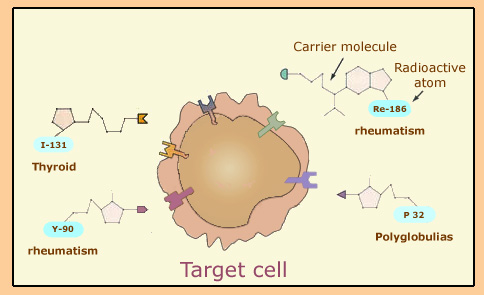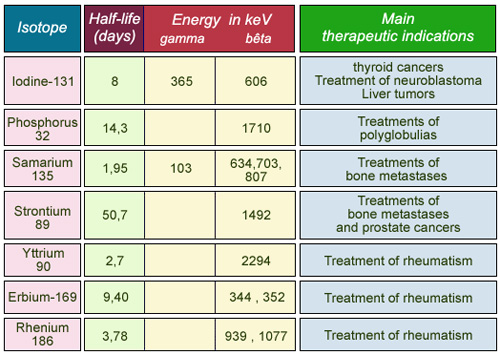Therapeutic Radioisotopes

Target cells
In metabolic therapies, the aim is to target diseased cells with appropriate radiopharmaceutical products. Radioactive atoms are administered to the patient via a carrier molecule having affinities with these cells. Once these molecules assimilated, the radioactive atom enter directly in contact with the cell. When it decays, the beta electron emitted deposits its energy by ionization inside it. The damage caused by ionizing radiation provokes its destruction.
© IN2P3
Applications of radioisotopes in nuclear medicine are not limited to scintigraphy or tomography by positron emission. In “metabolic radiotherapy“ beta-minus emitters (or even alpha) are used for therapeutic, curative or palliative aim. Because of their short-range distance in living matter, unlike gamma rays, these radiations remain confined to the organ to heal or the tumour to destroy.
As in the case of scintigraphic imaging, a radiopharmaceutical is administered to the patient. The main goal is not to make an image but to deliver a high dose (higher than 50 Grays) to the targeted volume, even if the beta radiation is often accompanied by gamma  radiation allowing localization.
radiation allowing localization.
Accordingly, the activities administered to the patient for metabolic therapies are much higher than those administered for a diagnosis.
Significant doses are expressed in grays. They represent a deposit of energy per unit volume. These are local doses delivered to the tumour that should not be confused with the effective dose – expressed in millisieverts – which measures the dose received for the « whole body ».

Radioisotopes in metabolic therapies and applications
Table of radioisotopes used for metabolic therapy: radioactive period (half-life), energy of radiations and applications.
© IN2P3
Iodine-131 has long been used to treat hyperthyroidism and thyroid cancer after surgery. Activities administered to the patient are very important and therefore induce a hospitalization in special rooms (called protected rooms). During the treatment period, special radiation protection measures, in particular for the medical staff, are taken (separate collection of urine from the patient, prohibition of visits, limitation of staff exposure).
Yttrium-90, erbium-169 and rhenium-186 are used for the treatment of rheumatism by intra-articular injection. These treatments do not require hospitalization. Indeed, these radioisotopes are pure radioactive beta emitters that do not emit gamma rays, which could cause problems for the environment.
Other articles on the subject « Radiation Therapy »
Radiotherapies
X-rays but no radioactivity Radiotherapy today denotes all cancer treatments based on ionizing ra[...]
Brachytherapies
The oldest nuclear therapy modernized today Brachytherapies (or Curietherapies) are the oldest th[...]
Prostate Brachytherapy
An Efficient destruction of cancerous cells Since the 2000s, particularly in the United States an[...]
Protontherapies
Proton therapy: an advanced and precise radiotherapy Proton therapy involves treating tumors with[...]
Secondary Risks
Alternative: exposure to radiation or let the cancer evolve… For over 20 years, there has b[...]